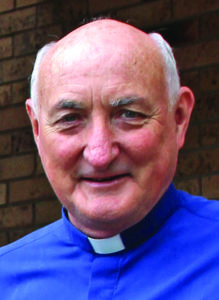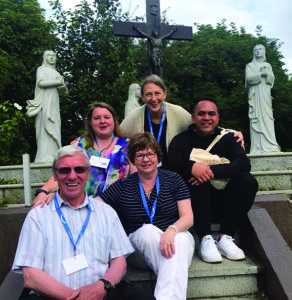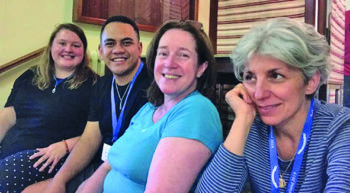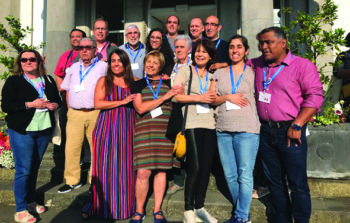Discerning Together

By Fr John Larsen SM
Paths for Marists to Walk Confidently into the Future
Part 2 of 3
The commitment
Once a person believes that he or she is called to live the lay vocation as a Marist, there comes the challenge of how to commit to this vocation.
This is an area that needs to be clarified -- how to make a commitment as a Lay Marist. In one sense, there are as many ways to make a commitment as there are Lay Marists. Anyone can read, study, pray and discern and make a commitment to God privately and seriously. The form of the commitment can be a private prayer or a private promise or even a private vow.
However, these days, there seems to be a desire expressed among some people (I am not sure how widely spread this desire is) to make some sort of public commitment. It could be a public commitment such as was traditionally made by Third Order members. Or it could be a vow to live the Marist Life fully as a lay person. At the moment, there really is no formal forum that I know of for this to happen. I suggest that a good work for this lay gathering would be to discuss the possibility of a form of vow that some Lay Marists could take for some determined time, or even for life. In fact, it is beginning to happen in some places. More work needs to be done – led by lay people who are concerned about this – and discussed with Marists in the local Church – to propose the possibility of making a temporary or life-long commitment as a Lay Marist.
The vow, of course, is made to God. But who would receive it and support the person making the vow? It would be more than proposing a formula. It would also involve proposing what the commitment would entail. There could be certain prayer forms. There could be an agreement to meet, or even live, in groups. Or it could be a commitment to Marist mission as Lay Marists for a shorter or longer period of time. What is clear is that this form of pubic commitment – its form and expression – is not clear. The primary people to clarify this: you ... though many professed Marists, I am sure, will be only too happy to accompany your considerations if we are invited!

At St Brigid’s Shrine, Faughart
The ecclesial dimension
So, there is the call and the commitment as Lay Marists. However, for any call and commitment to be sustainable it needs to have an ecclesial, communal expression. There need to be structures that support it.
At present in the Lay Marist world there are lots of Lay Marist communal structures. This is a blessing. ‘One size fits all’ has never been the Lay Marist way. There is a rich multitude of structures across the Marist world – the Americas and Europe, Africa, Asia and the Pacific. However, there can be so many structures and variations that there is nothing very defined and most of the structures will come to depend on a charismatic figure or tradition. Once this charismatic leader disappears the structure will also disappear.
So, here is another task for this gathering of Lay Marists in Ireland this year. Without in any way diminishing the varied forms of Marist communities that already exist, there is a need to propose a few options for building Marist Lay communities and offering them as possibilities for a way forward, so that the Lay Marist vocation has some way of finding a concrete community expression that is greater than any one charismatic leader.
Mission
So far, we have said that discerning paths for Marists to walk confidently into the future will involve a sense of personal call which is responded to with a more or less formal commitment in the context of a recognisable ecclesial, communal structure. All of this is essential.
However, I do not believe it is sufficient. The call, the response, and the common Lay Marist life needs to bear fruit in a specific mission. Mary gave birth to a Son whose mission was “to bring Good news to the poor”. Lay Marists share that mission.

Delgates at the Lay Marist Conference in Ireland, 2019:
Penelope (Australia), Tutangata (NZ), Sharon (Ireland) and Alexandra (France)
How this mission finds expression in the local context is the work of discernment for Lay Marists together and individually. However, we will know we are close to God when we find him with the poor, the stranger, the prisoner, the naked (Matthew 25). The 2017 Chapter of the Society of Mary – priests and brothers – specified our mission as especially among the young, the poor and the migrants. However, what is clear is that Marist spirituality in all its simplicity, beauty and compassion is not a spiritual never-never land. It is seriously incarnated. Just as Mary went out “at once into the hill country of Galilee”, so Lay Marists are called to go out to the peripheries and bring the Good News to the poor right there. Normally these would be the peripheries around the area where this or that individual Marist or Marist group lives.
Personally, I have experienced the rich blessing of working alongside many Lay Marists in foreign mission lands. My ministry in the southern Philippines island of Mindanao was usually blessed by working in a team with Lay Marists – whether it was giving retreats to young people, working in prison ministry, ministering in parishes or working in seminary formation. Almost always, there were lay people who were essential partners in the team. However, I do wonder if we were so busy on mission that we neglected the more fundamental but essential work of clarifying what their Marist call meant, and how it was to be expressed in a spiritual ecclesial commitment. When the mission or missionary moved on, the Lay Marists also often moved on.
An even more intense experience of Lay Marist mission was in my work among migrants suffering, and usually dying, with the HIV/Aids virus on the Thai-Burma border; and with migrant education there. There were many Lay Marists who came and volunteered to work with us and, for the most part, they were wonderful. We came to realise, by painful mistakes, that we needed to clarify the distinctly different vocations of Lay Marists and Religious Marists. We learned the hard way that we need to respect and honour the differences between Lay and Religious Marists. It is too easy to say “we all share one Marist vocation, so let’s just undertake the mission together”. There is some truth in the statement. However, for that truth to be lived out to the full, we need to discuss our differences and respect them. Then, indeed, we can work together in mission.

Spanish-speaking group at the conference
Recently I was in Guatemala at the Marist Youth Gathering, which was a wonderful celebration of vigorous faith as one Marist family – the Marist Sisters, the Marist Missionary Sisters, the Marist Brothers and the Priests and Brothers of the Society of Mary – as well, and especially, as Lay Marist youth. I challenged the young people to make themselves available for Marist mission abroad. I realised I had been premature. Several young people later came up and said: “Yes. We are ready. Where do you want us to go? We will go anywhere in the world!”
I realised we were unprepared to accompany them. This is yet another challenge for this gathering. If people believe they are called to give a sustained period of time on full-time Marist mission as lay people, how can we establish structures and processes that will channel that calling?
However, for most Lay Marists, I guess it is not primarily going to some remote place for a year or two, or more, on Marist mission. It is much more localised. My point is that an authentic Marist Lay vocation needs to have a missionary expression that involves dirtying our Marist hands in our commitment to bring the Good News to the poor, wherever we find ourselves. Otherwise, we risk becoming, as Pope Francis says so often, “self-referential”.
 Entries(RSS)
Entries(RSS)